The Way of the Cross
Saint Alphonsus De Liguori
This work is published for the greater Glory of Jesus Christ through His most Holy Mother Mary and for the sanctification of the militant Church and her members.
PUBLISHER: eCatholic2000.com
INDEX
THE WAY OF THE CROSS
PRAYERS
WAY OF THE CROSS INFORMATION
THE WAY OF THE CROSS
Kneeling before the altar, make an Act of Contrition, and form the intention of gaining the indulgences, whether for yourself or for the souls in Purgatory.
Preparatory Prayer
My Lord Jesus Christ, Thou hast made this journey to die for me with love unutterable, and I have so many times unworthily abandoned Thee; but now I love Thee with my whole heart, and because I love Thee, I repent sincerely for ever having offended Thee. Pardon me, my God, and permit me to accompany Thee on this journey. Thou goest to die for love of me; I wish also, my beloved Redeemer, to die for love of Thee. My Jesus, I will live and die always united to Thee.
Station 1: Jesus is Condemned to Death
V. We adore Thee, O Christ, and we bless Thee.
R. Because by Thy holy Cross, Thou hast redeemed the world.
Consider how Jesus, after having been scourged and crowned with thorns, was unjustly condemned by Pilate to die on the Cross.
My adorable Jesus, it was not Pilate, no, it was my sins that condemned Thee to die. I beseech Thee, by the merits of this sorrowful journey, to assist my soul in its journey towards eternity. I love Thee, my beloved Jesus; I repent with my whole heart for having offended Thee. Never permit me to separate myself from Thee again. Grant that I may love Thee always; and then do with me what Thou wilt.
Our Father, Hail Mary and Glory Be.
Dear Jesus, Thou dost go to die
For very love of me:
Ah! let me bear Thee company;
I wish to die with Thee.
V. Have mercy on us, O Lord.
R. Have mercy on us.
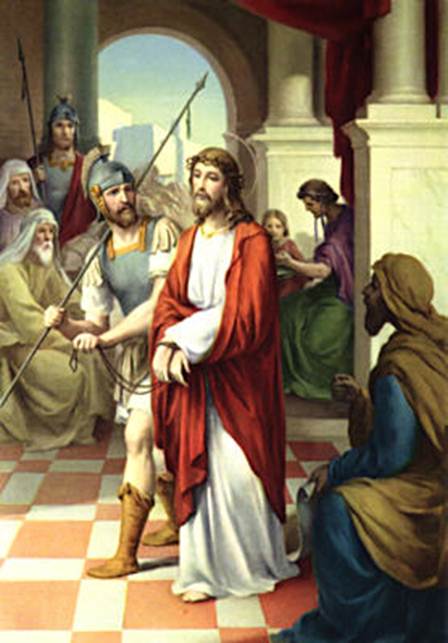
Station 2: Jesus Bears His Cross
V. We adore Thee, O Christ, and we bless Thee.
R. Because by Thy holy Cross, Thou hast redeemed the world.
Consider how Jesus, in making this journey with the Cross on His shoulders thought of us, and for us offered to His Father the death He was about to undergo.
My most beloved Jesus, I embrace all the tribulations Thou hast destined for me until death. I beseech Thee, by the merits of the pain Thou didst suffer in carrying Thy Cross, to give me the necessary help to carry mine with perfect patience and resignation. I love Thee, Jesus my love; I repent of having offended Thee. Never permit me to separate myself from Thee again. Grant that I may love Thee always; and then do with me what Thou wilt.
Our Father, Hail Mary and Glory Be.
Dear Jesus, Thou dost go to die
For very love of me:
Ah! let me bear Thee company;
I wish to die with Thee.
V. Have mercy on us, O Lord.
R. Have mercy on us.
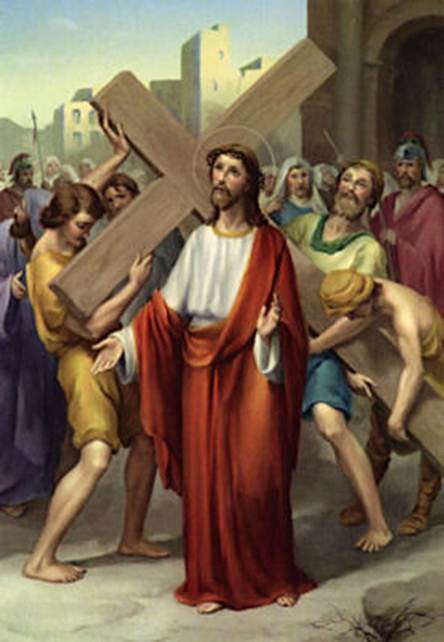
Station 3: Jesus Falls the First Time
V. We adore Thee, O Christ, and we bless Thee.
R. Because by Thy holy Cross, Thou hast redeemed the world.
Consider this first fall of Jesus under His Cross. His flesh was torn by the scourges, His head crowned with thorns, and He had lost a great quantity of blood. He was so weakened that he could scarcely walk, and yet he had to carry this great load upon His shoulders. The soldiers struck Him rudely, and thus He fell several times in His journey.
My beloved Jesus, it is not the weight of the Cross, but my sins, which have made Thee suffer so much pain. Ah, by the merits of this first fall, deliver me from the misfortune of falling into mortal sin. I love Thee, O my Jesus, with my whole heart; I repent of having offended Thee. Never permit me to separate myself from Thee again. Grant that I may love Thee always; and then do with me what Thou wilt.
Our Father, Hail Mary and Glory Be.
Dear Jesus, Thou dost go to die
For very love of me:
Ah! let me bear Thee company;
I wish to die with Thee.
V. Have mercy on us, O Lord.
R. Have mercy on us.
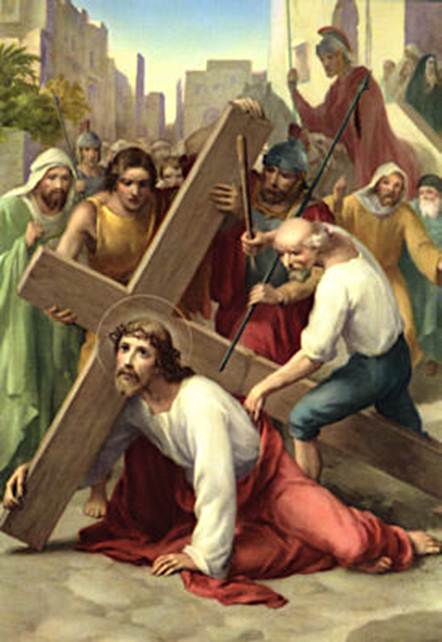
Station 4: Jesus Meets His Mother
V. We adore Thee, O Christ, and we bless Thee.
R. Because by Thy holy Cross, Thou hast redeemed the world.
Consider the meeting of the Son and the Mother, which took place on this journey. Jesus and Mary looked at each other, and their looks became as so many arrows to wound those hearts which loved each other so tenderly.
My most loving Jesus, by the sorrow Thou didst experience in this meeting, grant me the grace of a truly devoted love for Thy most holy Mother. And thou, my Queen, who wast overwhelmed with sorrow, obtain for me by thy intercession a continual and tender remembrance of the Passion of thy Son. I love Thee, Jesus my love; I repent of ever having offended Thee. Never permit me to offend Thee again. Grant that I may love Thee always; and then do with me what Thou wilt.
Our Father, Hail Mary and Glory Be.
Dear Jesus, Thou dost go to die
For very love of me:
Ah! let me bear Thee company;
I wish to die with Thee.
V. Have mercy on us, O Lord.
R. Have mercy on us.
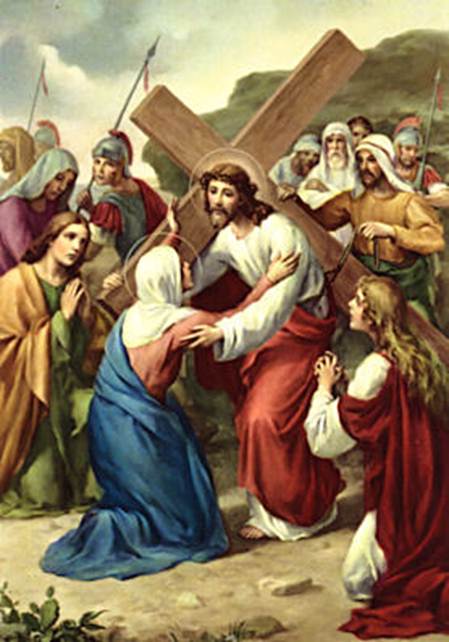
Station 5: Jesus is Helped by Simon
V. We adore Thee, O Christ, and we bless Thee.
R. Because by Thy holy Cross, Thou hast redeemed the world.
Consider how the Jews, seeing that at each step Jesus from weakness was on the point of expiring, and fearing that He would die on the way, when they wished Him to die the ignominious death of the Cross, constrained Simon the Cyrenian to carry the Cross behind our Lord.
My most sweet Jesus, I will not refuse the Cross, as the Cyrenian did; I accept it; I embrace it. I accept in particular the death Thou hast destined for me; with all the pains that may accompany it; I unite it to Thy death, I offer it to Thee. Thou hast died for love of me; I will die for love of Thee, and to please Thee. Help me by Thy grace. I love Thee, Jesus my love; I repent of having offended Thee. Never permit me to offend Thee again. Grant that I may love Thee always; and then do with me what Thou wilt.
Our Father, Hail Mary and Glory Be.
Dear Jesus, Thou dost go to die
For very love of me:
Ah! let me bear Thee company;
I wish to die with Thee.
V. Have mercy on us, O Lord.
R. Have mercy on us.
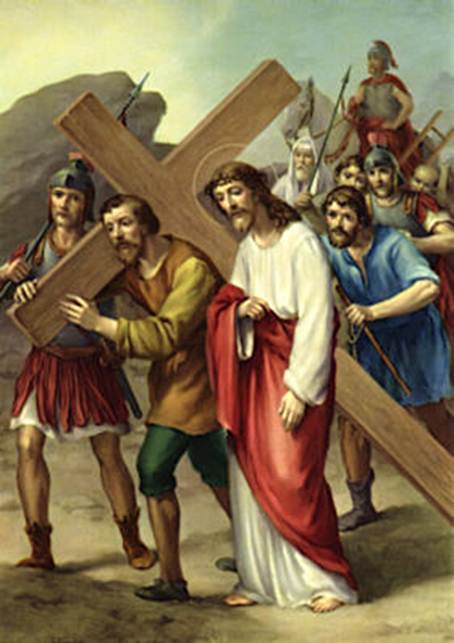
Station 6: Veronica Wipes the Face of Jesus
V. We adore Thee, O Christ, and we bless Thee.
R. Because by Thy holy Cross, Thou hast redeemed the world.
Consider how the holy woman named Veronica, seeing Jesus so afflicted, and His face bathed in sweat and blood, presented Him with a towel, with which He wiped His adorable face, leaving on it the impression of His holy countenance.
My most beloved Jesus, Thy face was beautiful before, but in this journey it has lost all its beauty, and wounds and blood have disfigured it. Alas, my soul also was once beautiful, when it received Thy grace in Baptism; but I have disfigured it since by my sins; Thou alone, my Redeemer, canst restore it to its former beauty. Do this by Thy Passion, O Jesus. I repent of having offended Thee. Never permit me to offend Thee again. Grant that I may love Thee always; and then do with me what Thou wilt.
Our Father, Hail Mary and Glory Be.
Dear Jesus, Thou dost go to die
For very love of me:
Ah! let me bear Thee company;
I wish to die with Thee.
V. Have mercy on us, O Lord.
R. Have mercy on us.
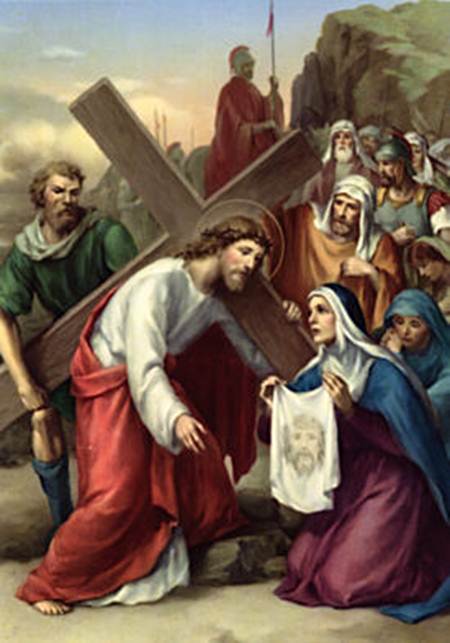
Station 7: Jesus Falls a Second Time
V. We adore Thee, O Christ, and we bless Thee.
R. Because by Thy holy Cross, Thou hast redeemed the world.
Consider the second fall of Jesus under the Cross—a fall which renews the pain of all the wounds of the head and members of our afflicted Lord.
My most gentle Jesus, how many times Thou hast pardoned me, and how many times have I fallen again, and begun again to offend Thee! Oh, by the merits of this new fall, give me the necessary help to persevere in Thy grace until death. Grant that in all temptations which assail me I may always commend myself to Thee. I love Thee, Jesus my love; I repent of having offended Thee. Never permit me to offend Thee again. Grant that I may love Thee always; and then do with me what Thou wilt.
Our Father, Hail Mary and Glory Be.
Dear Jesus, Thou dost go to die
For very love of me:
Ah! let me bear Thee company;
I wish to die with Thee.
V. Have mercy on us, O Lord.
R. Have mercy on us.
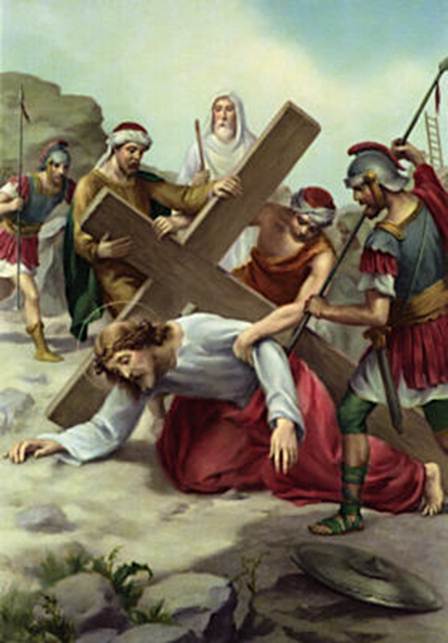
Station 8: Jesus Speaks to the Women
V. We adore Thee, O Christ, and we bless Thee.
R. Because by Thy holy Cross, Thou hast redeemed the world.
Consider how those women wept with compassion at seeing Jesus in such a pitiable state, streaming with blood, as He walked along. But Jesus said to them: Weep not for Me, but for your children.
My Jesus, laden with sorrows, I weep for the offences I have committed against Thee, because of the pains they have deserved, and still more because of the displeasure they have caused Thee, who hast loved me so much. It is Thy love, more than the fear of hell, which causes me to weep for my sins. My Jesus, I love Thee more than myself; I repent of having offended Thee. Never permit me to offend Thee again. Grant that I may love Thee always; and then do with me what Thou wilt.
Our Father, Hail Mary and Glory Be.
Dear Jesus, Thou dost go to die
For very love of me:
Ah! let me bear Thee company;
I wish to die with Thee.
V. Have mercy on us, O Lord.
R. Have mercy on us.
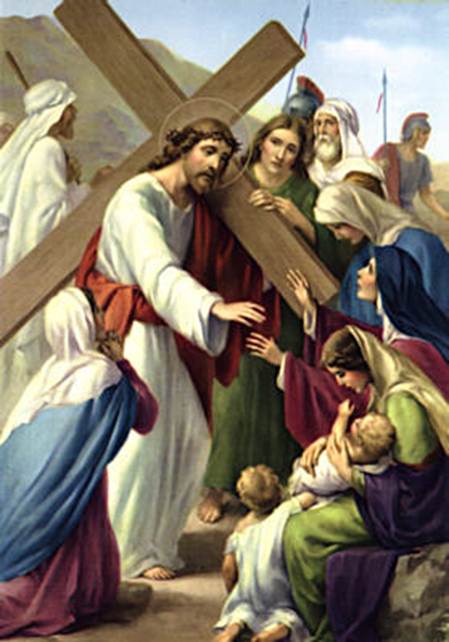
Station 9: Jesus Falls a Third Time
V. We adore Thee, O Christ, and we bless Thee.
R. Because by Thy holy Cross, Thou hast redeemed the world.
Consider the third fall of Jesus Christ. His weakness was extreme, and the cruelty of His executioners was excessive, who tried to hasten His steps when He had scarcely strength to move.
Ah, my outraged Jesus, by the merits of the weakness Thou didst suffer in going to Calvary, give me strength sufficient to conquer all human respect, and all my wicked passions, which have led me to despise Thy friendship. I love Thee, Jesus my love, with my whole heart; I repent of having offended Thee. Never permit me to offend Thee again. Grant that I may love Thee always; and then do with me what Thou wilt.
Our Father, Hail Mary and Glory Be.
Dear Jesus, Thou dost go to die
For very love of me:
Ah! let me bear Thee company;
I wish to die with Thee.
V. Have mercy on us, O Lord.
R. Have mercy on us.
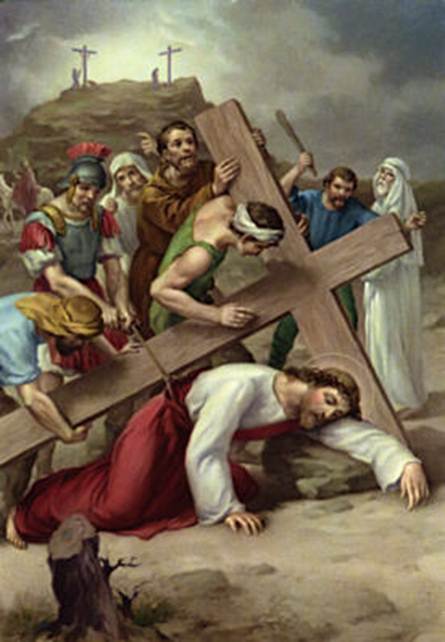
Station 10: Jesus is Stripped of His Garments
V. We adore Thee, O Christ, and we bless Thee.
R. Because by Thy holy Cross, Thou hast redeemed the world.
Consider the violence with which the executioners stripped Jesus. His inner garments adhered to His torn flesh, and they dragged them off so roughly that the skin came with them. Compassionate your Savior thus cruelly treated, and say to Him:
My innocent Jesus, by the merits of the torment Thou hast felt, help me to strip myself of all affection to things of earth, in order that I may place all my love in Thee, who art so worthy of my love. I love Thee, O Jesus, with my whole heart; I repent of having offended Thee. Never permit me to offend Thee again. Grant that I may love Thee always; and then do with me what Thou wilt.
Our Father, Hail Mary and Glory Be.
Dear Jesus, Thou dost go to die
For very love of me:
Ah! let me bear Thee company;
I wish to die with Thee.
V. Have mercy on us, O Lord.
R. Have mercy on us.

Station 11: Jesus is Nailed to the Cross
V. We adore Thee, O Christ, and we bless Thee.
R. Because by Thy holy Cross, Thou hast redeemed the world.
Consider how Jesus, after being thrown on the Cross extended His hands, and offered to His Eternal Father the sacrifice of His death for our salvation. These barbarians fastened Him with nails, and then, raising the Cross, allowed Him to die with anguish on this infamous gibbet.
My Jesus! loaded with contempt, nail my heart to Thy feet, that it may ever remain there, to love Thee, and never quit Thee again. I love Thee more than myself; I repent of having offended Thee. Never permit me to offend Thee again. Grant that I may love Thee always; and then do with me what Thou wilt.
Our Father, Hail Mary and Glory Be.
Dear Jesus, Thou dost go to die
For very love of me:
Ah! let me bear Thee company;
I wish to die with Thee.
V. Have mercy on us, O Lord.
R. Have mercy on us.
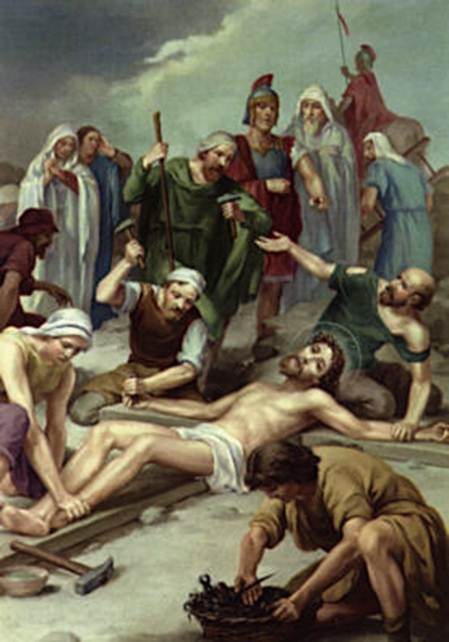
Station 12: Jesus Dies on the Cross
V. We adore Thee, O Christ, and we bless Thee.
R. Because by Thy holy Cross, Thou hast redeemed the world.
Consider how thy Jesus, after three hours’ Agony on the Cross, consumed at length with anguish, abandons Himself to the weight of His body, bows His head, and dies.
O my dying Jesus, I kiss devoutly the Cross on which Thou didst die for love of me. I have merited by my sins to die a miserable death; but Thy death is my hope. Ah, by the merits of Thy death, give me grace to die, embracing Thy feet, and burning with love for Thee. I yield my soul into Thy hands. I love Thee with my whole heart; I repent of ever having offended Thee. Never permit me to offend Thee again. Grant that I may love Thee always; and then do with me what Thou wilt.
Our Father, Hail Mary and Glory Be.
Dear Jesus, Thou dost go to die
For very love of me:
Ah! let me bear Thee company;
I wish to die with Thee.
V. Have mercy on us, O Lord.
R. Have mercy on us.
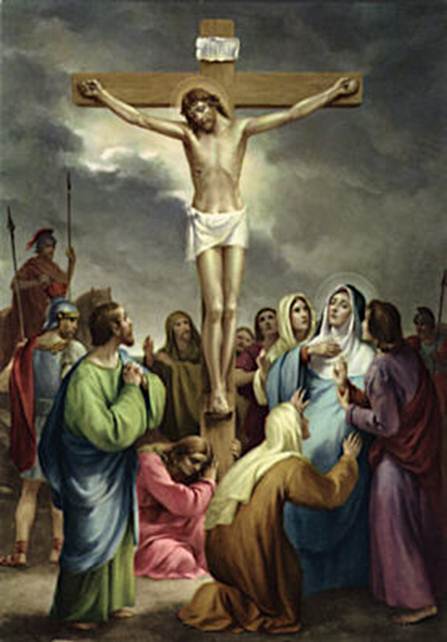
Station 13: Jesus is Taken Down from the Cross
V. We adore Thee, O Christ, and we bless Thee.
R. Because by Thy holy Cross, Thou hast redeemed the world.
Consider how, after the death of our Lord, two of His disciples, Joseph and Nicodemus, took Him down from the Cross, and placed Him in the arms of His afflicted Mother, who received Him with unutterable tenderness, and pressed Him to her bosom.
O Mother of sorrow, for the love of this Son, accept me for thy servant, and pray to Him for me. And Thou, my Redeemer, since Thou hast died for me, permit me to love Thee; for I wish but Thee, and nothing more. I love Thee, my Jesus, and I repent of ever having offended Thee. Never permit me to offend Thee again. Grant that I may love Thee always; and then do with me what Thou wilt.
Our Father, Hail Mary and Glory Be.
Dear Jesus, Thou dost go to die
For very love of me:
Ah! let me bear Thee company;
I wish to die with Thee.
V. Have mercy on us, O Lord.
R. Have mercy on us.
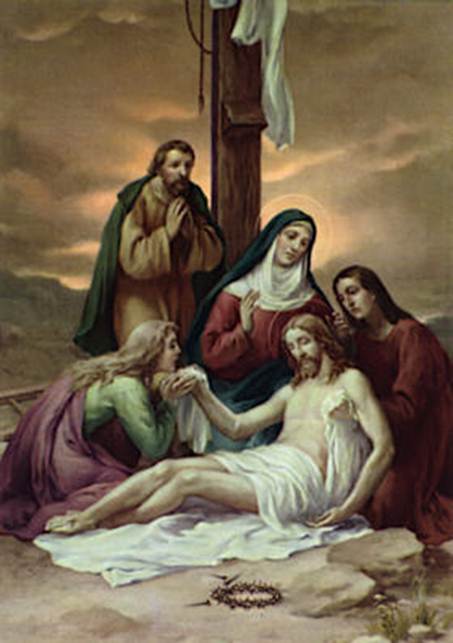
Station 14: Jesus is Placed in the Tomb
V. We adore Thee, O Christ, and we bless Thee.
R. Because by Thy holy Cross, Thou hast redeemed the world.
Consider how the disciples carried the body of Jesus to bury it, accompanied by His holy Mother, who arranged it in the sepulchre with her own hands. They then closed the tomb, and all withdrew.
Oh, my buried Jesus, I kiss the stone that encloses Thee. But Thou didst rise again the third day. I beseech Thee, by Thy resurrection, make me rise glorious with Thee at the last day, to be always united with Thee in heaven, to praise Thee and love Thee forever. I love Thee, and I repent of ever having offended Thee. Never permit me to offend Thee again. Grant that I may love Thee always; and then do with me what Thou wilt.
Our Father, Hail Mary and Glory Be.
Dear Jesus, Thou dost go to die
For very love of me:
Ah! let me bear Thee company;
I wish to die with Thee.
V. Have mercy on us, O Lord.
R. Have mercy on us.
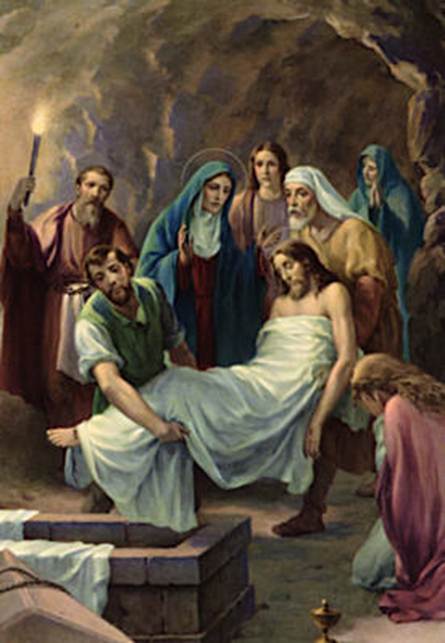
Ending
After this, say the Our Father, Hail Mary and Glory Be, five times, in honour of the Passion of Jesus Christ, to gain other indulgences granted those who recite them. Lastly, say one Our Father, Hail Mary and Glory Be, for the intention of the Sovereign Pontiff.
St Alphonsus Liguori, Pray for us! Amen.
PRAYERS
Glory Be
Glory Be to the Father, and to the Son, and to the Holy Spirit. As it was in the beginning, is now, and ever shall be, world without end. Amen.
Hail Mary
Hail Mary, Full of Grace, The Lord is with Thee. Blessed art Thou among women, and Blessed is the Fruit of Thy Womb, Jesus. Holy Mary, Mother of God, pray for us sinners now, and at the hour of death. Amen.
Our Father
Our Father, Who art in Heaven, Hallowed be Thy Name. Thy Kingdom come, Thy Will be done, On earth as it is in Heaven. Give us this day Our daily bread, and Forgive us our trespasses as we forgive those who trespass against us. And lead us not into temptation, but deliver us from evil. Amen.
Act of Contrition
O my God, because You are so good. I am very sorry that I have sinned against You; and with the help of Your Grace, I will try not to sin again. Amen.
Stabat Mater - Latin and English
| Latin | English |
|---|---|
| Stabat mater dolorosa juxta Crucem lacrimosa, dum pendebat Filius. |
At the Cross her station keeping, stood the mournful Mother weeping, close to her Son to the last. |
| Cuius animam gementem, contristatam et dolentem pertransivit gladius. |
Through her heart, His sorrow sharing, all His bitter anguish bearing, now at length the sword has passed. |
| O quam tristis et afflicta fuit illa benedicta, mater Unigeniti! |
O how sad and sore distressed was that Mother, highly blest, of the sole-begotten One. |
| Quae moerebat et dolebat, pia Mater, dum videbat nati poenas inclyti. |
Christ above in torment hangs, she beneath beholds the pangs of her dying glorious Son. |
| Quis est homo qui non fleret, matrem Christi si videret in tanto supplicio? |
Is there one who would not weep, whelmed in miseries so deep, Christ’s dear Mother to behold? |
| Quis non posset contristari Christi Matrem contemplari dolentem cum Filio? |
Can the human heart refrain from partaking in her pain, in that Mother’s pain untold? |
| Pro peccatis suae gentis vidit Iesum in tormentis, et flagellis subditum. |
For the sins of His own nation, She saw Jesus wracked with torment, All with scourges rent: |
| Vidit suum dulcem Natum moriendo desolatum, dum emisit spiritum. |
She beheld her tender Child, Saw Him hang in desolation, Till His spirit forth He sent. |
| Eia, Mater, fons amoris me sentire vim doloris fac, ut tecum lugeam. |
O thou Mother! fount of love! Touch my spirit from above, make my heart with thine accord: |
| Fac, ut ardeat cor meum in amando Christum Deum ut sibi complaceam. |
Make me feel as thou hast felt; make my soul to glow and melt with the love of Christ my Lord. |
| Sancta Mater, istud agas, crucifixi fige plagas cordi meo valide. |
Holy Mother! pierce me through, in my heart each wound renew of my Savior crucified: |
| Tui Nati vulnerati, tam dignati pro me pati, poenas mecum divide. |
Let me share with thee His pain, who for all my sins was slain, who for me in torments died. |
| Fac me tecum pie flere, crucifixo condolere, donec ego vixero. |
Let me mingle tears with thee, mourning Him who mourned for me, all the days that I may live: |
| Juxta Crucem tecum stare, et me tibi sociare in planctu desidero. |
By the Cross with thee to stay, there with thee to weep and pray, is all I ask of thee to give. |
| Virgo virginum praeclara, mihi iam non sis amara, fac me tecum plangere. |
Virgin of all virgins blest!, Listen to my fond request: let me share thy grief divine; |
| Fac, ut portem Christi mortem, passionis fac consortem, et plagas recolere. |
Let me, to my latest breath, in my body bear the death of that dying Son of thine. |
| Fac me plagis vulnerari, fac me Cruce inebriari, et cruore Filii. |
Wounded with His every wound, steep my soul till it hath swooned, in His very Blood away; |
| Flammis ne urar succensus, per te, Virgo, sim defensus in die iudicii. |
Be to me, O Virgin, nigh, lest in flames I burn and die, in His awful Judgment Day. |
| Christe, cum sit hinc exire, da per Matrem me venire ad palmam victoriae. |
Christ, when Thou shalt call me hence, by Thy Mother my defense, by Thy Cross my victory; |
| Quando corpus morietur, fac, ut animae donetur paradisi gloria. Amen. |
While my body here decays, may my soul Thy goodness praise, Safe in Paradise with Thee. |
Information about the Way of the Cross
Way of the Cross (Also called Stations of the Cross, Via Crucis, and Via Dolorosa). These names are used to signify either a series of pictures or tableaux representing certain scenes in the Passion of Christ, each corresponding to a particular incident, or the special form of devotion connected with such representations.
Taken in the former sense, the Stations may be of stone, wood, or metal, sculptured or carved, or they may be merely paintings or engravings. Some Stations are valuable works of art, as those, for instance, in Antwerp cathedral, which have been much copied elsewhere. They are usually ranged at intervals around the walls of a church, though sometimes they are to be found in the open air, especially on roads leading to a church or shrine. In monasteries they are often placed in the cloisters. The erection and use of the Stations did not become at all general before the end of the seventeenth century, but they are now to be found in almost every church. Formerly their number varied considerably in different places but fourteen are now prescribed by authority. They are as follows:
1. Christ condemned to death;
2. The cross is laid upon him;
3. His first fall;
4. He meets His Blessed Mother;
5. Simon of Cyrene is made to bear the cross;
6. Christ’s face is wiped by Veronica;
7. His second fall;
8. He meets the women of Jerusalem;
9. His third fall;
10. He is stripped of His garments;
11. His crucifixion;
12. His death on the cross;
13. His body is taken down from the cross; and
14. Laid in the tomb.
The object of the Stations is to help the faithful to make in spirit, as it were, a pilgrimage to the chief scenes of Christ’s sufferings and death, and this has become one of the most popular of Catholic devotions. It is carried out by passing from Station to Station, with certain prayers at each and devout meditation on the various incidents in turn. It is very usual, when the devotion is performed publicly, to sing a stanza of the “Stabat Mater” while passing from one Station to the next.
Inasmuch as the Way of the Cross, made in this way, constitutes a miniature pilgrimage to the holy places at Jerusalem, the origin of the devotion may be traced to the Holy Land. The Via Dolorosa at Jerusalem (though not called by that name before the sixteenth century) was reverently marked out from the earliest times and has been the goal of pious pilgrims ever since the days of Constantine. Tradition asserts that the Blessed Virgin used to visit daily the scenes of Christ’s Passion and St. Jerome speaks of the crowds of pilgrims from all countries who used to visit the holy places in his day. There is, however, no direct evidence as to the existence of any set form of the devotion at that early date, and it is noteworthy that St. Sylvia (c. 380) says nothing about it in her “Peregrinatio ad loca sancta,” although she describes minutely every other religious exercise that she saw practised there. A desire to reproduce the holy places in other lands, in order to satisfy the devotion of those who were hindered from making the actual pilgrimage, seems to have manifested itself at quite an early date. At the monastery of San Stefano at Bologna a group of connected chapels were constructed as early as the fifth century, by St. Petronius, Bishop of Bologna, which were intended to represent the more important shrines of Jerusalem, and in consequence, this monastery became familiarly known as “Hierusalem.” These may perhaps be regarded as the germ from which the Stations afterwards developed, though it is tolerably certain that nothing that we have before about the fifteenth century can strictly be called a Way of the Cross in the modern sense. Several travellers, it is true, who visited the Holy Land during the twelfth, thirteenth, and fourteenth centuries, mention a “Via Sacra,” i.e., a settled route along which pilgrims were conducted, but there is nothing in their accounts to identify this with the Via Crucis, as we understand it, including special stopping-places with indulgences attached, and such indulgenced Stations must, after all, be considered to be the true origin of the devotion as now practised. It cannot be said with any certainty when such indulgences began to be granted, but most probably they may be due to the Franciscans, to whom in 1342 the guardianship of the holy places was entrusted. Ferraris mentions the following as Stations to which indulgences were attached: the place where Christ met His Blessed Mother, where He spoke to the women of Jerusalem, where He met Simon of Cyrene, where the soldiers cast lots for His garment, where He was nailed to the cross, Pilate’s house, and the Holy Sepulchre. Analogous to this it may be mentioned that in 1520 Leo X granted an indulgence of a hundred days to each of a set of sculptured Stations, representing the Seven Dolours of Our Lady, in the cemetery of the Franciscan Friary at Antwerp, the devotion connected with them being a very popular one. The earliest use of the word Stations, as applied to the accustomed halting-places in the Via Sacra at Jerusalem, occurs in the narrative of an English pilgrim, William Wey, who visited the Holy Land in 1458 and again in 1462, and who describes the manner in which it was then usual to follow the footsteps of Christ in His sorrowful journey. It seems that up to that time it had been the general practice to commence at Mount Calvary, and proceeding thence, in the opposite direction to Christ, to work back to Pilate’s house. By the early part of the sixteenth century, however, the more reasonable way of traversing the route, by beginning at Pilate’s house and ending at Mount Calvary, had come to be regarded as more correct, and it became a special exercise of devotion complete in itself. During the fifteenth and sixteenth centuries several reproductions of the holy places were set up in different parts of Europe. The Blessed Alvarez (d. 1420), on his return from the Holy Land, built a series of little chapels at the Dominican friary of Cordova, in which, after the pattern of separate Stations, were painted the principal scenes of the Passion. About the same time the Blessed Eustochia, a poor Clare, constructed a similar set of Stations in her convent at Messina. Others that may be enumerated were those at GÖrlitz, erected by G. Emmerich, about 1465, and at Nuremburg, by Ketzel, in 1468. Imitations of these were made at Louvain in 1505 by Peter Sterckx; at St. Getreu in Bamberg in 1507; at Fribourg and at Rhodes, about the same date, the two latter being in the commanderies of the Knights of Rhodes. Those at Nuremburg, which were carved by Adam Krafft, as well as some of the others, consisted of seven Stations, popularly known as “the Seven Falls,” because in each of them Christ was represented either as actually prostrate or as sinking under the weight of His cross. A famous set of Stations was set up in 1515 by Romanet Bofin at Romans in Dauphine, in imitation of those at Fribourg, and a similar set was erected in 1491 at Varallo by the Franciscans there, whose guardian, Blessed Bernardino Caimi, had been custodian of the holy places. In several of these early examples an attempt was made, not merely to duplicate the most hallowed spots of the original Via Dolorosa at Jerusalem, but also to reproduce the exact intervals between them, measured in paces, so that devout people might cover precisely the same distances as they would have done had they made the pilgrimage to the Holy Land itself. Boffin and some of the others visited Jerusalem for the express purpose of obtaining the exact measurements, but unfortunately, though each claimed to be correct, there is an extraordinary divergence between some of them.
With regard to the number of Stations it is not at all easy to determine how this came to be fixed at fourteen, for it seems to have varied considerably at different times and places. And, naturally, with varying numbers the incidents of the Passion commemorated also varied greatly. Wey’s account, written in the middle of the fifteenth century, gives fourteen, but only five of these correspond with ours, and of the others, seven are only remotely connected with our Via Crucis:
–The house of Dives,
–The city gate through which Christ passed,
–The probatic pool,
–The Ecce Homo arch,
–The Blessed Virgin’s school, and
–The houses of Herod and Simon the Pharisee.
When Romanet Boffin visited Jerusalem in 1515 for the purpose of obtaining correct details for his set of Stations at Romans, two friars there told him that there ought to be thirty-one in all, but in the manuals of devotion subsequently issued for the use of those visiting these Stations they are given variously as nineteen, twenty-five, and thirty-seven, so it seems that even in the same place the number was not determined very definitely. A book entitled “Jerusalem sicut Christi tempore floruit,” written by one Adrichomius and published in 1584, gives twelve Stations which correspond exactly with the first twelve of ours, and this fact is thought by some to point conclusively to the origin of the particular selection afterwards authorized by the Church, especially as this book had a wide circulation and was translated into several European languages. Whether this is so or not we cannot say for certain. At any rate, during the sixteenth century, a number of devotional manuals, giving prayers for use when making the Stations, were published in the Low Countries, and some of our fourteen appear in them for the first time. But whilst this was being done in Europe for the benefit of those who could not visit the Holy Land and yet could reach Louvain, Nuremburg, Romans, or one of the other reproductions of the Via Dolorosa, it appears doubtful whether, even up to the end of the sixteenth century, there was any settled form of the devotion performed publicly in Jerusalem, for Zuallardo, who wrote a book on the subject, published in Rome in 1587, although he gives a full series of prayers, etc., for the shrines within the Holy Sepulchre, which were under the care of the Franciscans, provides none for the Stations themselves. He explains the reason thus: “it is not permitted to make any halt, nor to pay veneration to them with uncovered head, nor to make any other demonstration.” From this it would seem that after Jerusalem had passed under the Turkish domination the pious exercises of the Way of the Cross could be performed far more devoutly at Nuremburg or Louvain than in Jerusalem itself. It may therefore be conjectured, with extreme probability, that our present series of Stations, together with the accustomed series of prayers for them, comes to us, not from Jerusalem, but from some of the imitation Ways of the Cross in different parts of Europe, and that we owe the propagation of the devotion, as well as the number and selection of our Stations, much more to the pious ingenuity of certain sixteenth-century devotional writers than to the actual practice of pilgrims to the holy places.
With regard to the particular subjects which have been retained in our series of Stations, it may be noted that very few of the medieval accounts make any mention of either the second (Christ receiving the cross) or the tenth (Christ being stripped of His garments), whilst others which have since dropped out appear in almost all the early lists. One of the most frequent of these is the Station formerly made at the remains of the Ecce Homo arch, i.e. the balcony from which these words were pronounced. Additions and omissions such as these seem to confirm the supposition that our Stations are derived from pious manuals of devotion rather than from Jerusalem itself. The three falls of Christ (third, seventh, and ninth Stations) are apparently all that remain of the Seven Falls, as depicted by Krafft at Nuremburg and his imitators, in all of which Christ was represented as either falling or actually fallen. In explanations of this it is supposed that the other four falls coincided with His meetings with His Mother, Simon of Cyrene, Veronica, and the women of Jerusalem, and that in these four the mention of the fall has dropped out whilst it survives in the other three which have nothing else to distinguish them. A few medieval writers take the meeting with Simon and the women of Jerusalem to have been simultaneous, but the majority represent them as separate events. The Veronica incident does not occur in many of the earlier accounts, whilst almost all of those that do mention it place it as having happened just before reaching Mount Calvary, instead of earlier in the journey as in our present arrangement. An interesting variation is found in the special set of eleven stations ordered in 1799 for use in the diocese of Vienne. It is as follows:
1. The Agony in the Garden;
2. The betrayal by Judas;
3. The scourging;
4. The crowning with thorns;
5. Christ condemned to death;
6. He meets Simon of Cyrene;
7. The women of Jerusalem;
8. He tastes the gall;
9. He is nailed to the cross;
10. His death on the cross; and
11. His body is taken down from the cross.
It will be noticed that only five of these correspond exactly with our Stations. The others, though comprising the chief events of the Passion, are not strictly incidents of the Via Dolorosa itself.
Another variation that occurs in different churches relates to the side of the church on which the Stations begin. The Gospel side is perhaps the more usual. In reply to a question the Sacred Congregation of Indulgences, in 1837, said that, although nothing was ordered on this point, beginning on the Gospel side seemed to be the more appropriate. In deciding the matter, however, the arrangement and form of a church may make it more convenient to go the other way. The position of the figures in the tableaux, too, may sometimes determine the direction of the route, for it seems more in accordance with the spirit of the devotion that the procession, in passing from station to station, should follow Christ rather than meet Him.
The erection of the Stations in churches did not become at all common until towards the end of the seventeenth century, and the popularity of the practice seems to have been chiefly due to the indulgences attached. The custom originated with the Franciscans, but its special connection with that order has now disappeared. It has already been said that numerous indulgences were formerly attached to the holy places at Jerusalem. Realizing that few persons, comparatively, were able to gain these by means of a personal pilgrimage to the Holy Land, Innocent XI, in 1686, granted to the Franciscans, in answer to their petition, the right to erect the Stations in all their churches, and declared that all the indulgences that had ever been given for devoutly visiting the actual scenes of Christ’s Passion, could thenceforth be gained by Franciscans and all others affiliated to their order if they made the Way of the Cross in their own churches in the accustomed manner. Innocent XII confirmed the privilege in 1694 and Benedict XIII in 1726 extended it to all the faithful. In 1731 Clement XII still further extended it by permitting the indulgenced Stations to all churches, provided that they were erected by a Franciscan father with the sanction of the ordinary. At the same time he definitely fixed the number of Stations at fourteen. Benedict XIV in 1742 exhorted all priests to enrich their churches with so great a treasure, and there are few churches now without the Stations. In 1857 the bishops of England received faculties from the Holy See to erect Stations themselves, with the indulgences attached, wherever there were no Franciscans available, and in 1862 this last restriction was removed and the bishops were empowered to erect the Stations themselves, either personally or by delegate, anywhere within their jurisdiction. These faculties are quinquennial. There is some uncertainty as to what are the precise indulgences belonging to the stations. It is agreed that all that have ever been granted to the faithful for visiting the holy places in person can now be gained by making the Via Crucis in any church where the Stations have been erected in due form, but the Instructions of the Sacred Congregation, approved by Clement XII in 1731, prohibit priests and others from specifying what or how many indulgences may be gained. In 1773 Clement XIV attached the same indulgence, under certain conditions, to crucifixes duly blessed for the purpose, for the use of the sick, those at sea or in prison, and others lawfully hindered from making the Stations in a church. The conditions are that, whilst holding the crucifix in their hands, they must say the “Pater” and “Ave” fourteen times, then the “Pater,” “Ave,” and “Gloria” five times, and the same again once each for the pope’s intentions. If one person hold the crucifix, a number present may gain the indulgences provided the other conditions are fulfilled by all. Such crucifixes cannot be sold, lent, or given away, without losing the indulgence.
The following are the principal regulations universally in force at the present time with regard to the Stations:
–If a pastor or a superior of a convent, hospital, etc., wishes to have the Stations erected in their places he must ask permission of the bishop. If there are Franciscan Fathers in the same town or city, their superior must be asked to bless the Stations or delegate some priest either of his own monastery or a secular priest. If there are no Franciscan Fathers in that place the bishops who have obtained from the Holy See the extraordinary of Form C can delegate any priest to erect the Stations. This delegation of a certain priest for the blessing of the Stations must necessarily be done in writing. The pastor of such a church, or the superior of such a hospital, convent, etc., should take care to sign the document the bishop or the superior of the monastery sends, so that he may thereby express his consent to have the Stations erected in their place, for the bishop’s and the respective pastor’s or superior’s consent must be had before the Stations are blessed, otherwise the blessing is null and void;
–Pictures or tableaux of the various Stations are not necessary. It is to the cross placed over them that the indulgence is attached. These crosses must be of wood; no other material will do. If only painted on the wall the erection is null (Cong. Ind., 1837, 1838, 1845);
–If, for restoring the church, for placing them in a more convenient position, or for any other reasonable cause, the crosses are moved, this may be done without the indulgence being lost (1845). If any of the crosses, for some reason, have to be replaced, no fresh blessing is required, unless more than half of them are so replaced (1839).
–There should if possible be a separate meditation on each of the fourteen incidents of the Via Crucis, not a general meditation on the Passion nor on other incidents not included in the Stations. No particular prayers are ordered;
–The distance required between the Stations is not defined. Even when only the clergy move from one Station to another the faithful can still gain the indulgence without moving;
–It is necessary to make all the Stations uninterruptedly (S.C.I., 22 January, 1858). Hearing Mass or going to Confession or Communion between Stations is not considered an interruption. According to many the Stations may be made more than once on the same day, the indulgence may be gained each time; but this is by no means certain (S.C.I., 10 Sept., 1883). Confession and Communion on the day of making the Stations are not necessary provided the person making them is in a state of grace;
–Ordinarily the Stations should be erected within a church or public oratory. If the Via Crucis goes outside, e.g., in a cemetery or cloister, it should if possible begin and end in the church.
In conclusion it may be safely asserted that there is no devotion more richly endowed with indulgences than the Way of the Cross, and none which enables us more literally to obey Christ’s injunction to take up our cross and follow Him. A perusal of the prayers usually given for this devotion in any manual will show what abundant spiritual graces, apart from the indulgences, may be obtained through a right use of them, and the fact that the Stations may be made either publicly or privately in any church renders the devotion specially suitable for all. One of the most popularly attended Ways of the Cross at the present day is that in the Colosseum at Rome, where every Friday the devotion of the Stations is conducted publicly by a Franciscan Father.
Copyright ©1999-2023 Wildfire Fellowship, Inc all rights reserved

 Keep Site Running
Keep Site Running